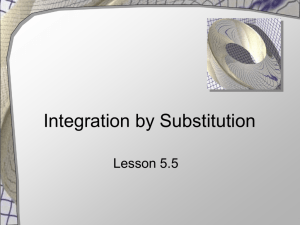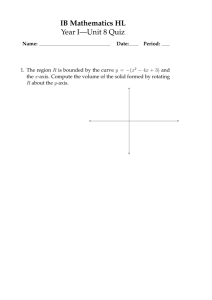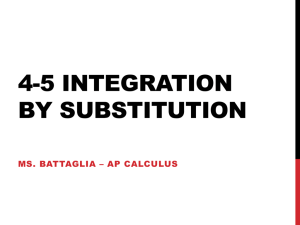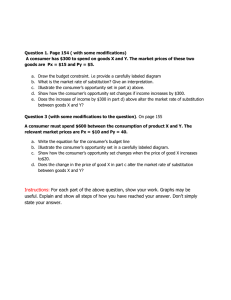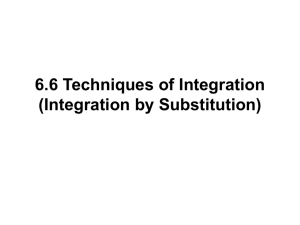Section 5.5
advertisement
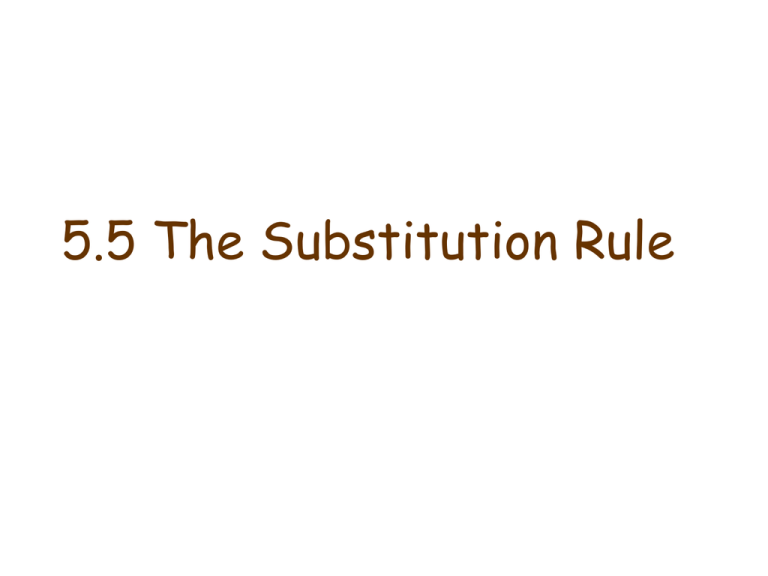
5.5 The Substitution Rule The Substitution Rule • If u=g(x) is differentiable function whose range is an interval I, and f is continuous on I, then f ( g ( x)) g '( x)dx f (u )du • The Substitution rule is proved using the Chain Rule for differentiation. • The idea behind the substitution rule is to replace a relatively complicated integral by a simpler integral. This is accomplished by changing from the original variable x to a new variable u that is a function of x. • The main challenge is to think of an appropriate substitution. Example x 2 5 dx u du Let u x 2 du dx 5 1 6 u C 6 x 2 6 6 C The variable of integration must match the variable in the expression. Don’t forget to substitute the value for u back into the problem! Substitution rule examples Example To compute e 2x dx set u 2 x. Then du 2dx dx 1 du and 2 1 u 1 u e du e C 2 2 1 e2 x C 2 2x e dx We computed du by straightforward differentiation of the expression for u. The substitution u = 2x was suggested by the function to be integrated. The main problem in integrating by substitution is to find the right substitution which simplifies the integral so that it can be computed by the table of basic integrals. Example about choosing the substitution Example Compute x 1 dx. x Here one is tempted to try the substitution u x 1, x u 1, dx du. One gets Solution x 1 u dx du. This is not any easier. x u 1 Substitute u x 1. Then x 1 u 2 , dx This rewriting allows us to and du dx 2udu. 2 x 1 finish the computation using basic formulae. x 1 u 1 dx 2 udu 2 1 du 2u 2arctan(u ) C 2 2 x 1 u 1 u Next substitute back to the original variable. Hence x 1 dx 2 x 1 2arctan( x 1) C x The substitution rule for definite integrals If g’ is continuous on [a,b], and f is continuous on the range of u=g(x) then b g (b ) f ( g ( x)) g '( x)dx a g (a) f (u )du The substitution rule for definite integrals e ln x Compute dx. x 1 Example The substitution t ln x is suggested by ln x x the function to be integrated. We have x 1 t 0 and x e t 1. 1 ln x t 1 Hence dx tdt . x 2 0 2 1 0 e 1 2 1 e The area of the yellow domain is ½. Example 4 0 tan x sec2 x dx new limit 1 0 u du new limit 1 1 2 u 2 0 1 2 Let u tan x du sec 2 x dx u 0 tan 0 0 u tan 1 4 4 Find new limits Example 1 1 3x Let u x3 1 x 1 dx 2 3 du 3x dx 2 2 0 1 2 u 1 0 u 1 2 u du 2 u 3 3 2 2 2 2 3 Don’t forget to use the new limits. 0 3 2 2 2 2 3 4 2 3 Integrals of Even and Odd Functions Theorem Assume that f is an even function, i.e., that f x f x x. Then a a a 0 f x dx 2 f x dx. Theorem Assume that f is an odd function, i.e., that f x f x x. Then a f x dx 0. a Integrals of Even and Odd Functions Problem Compute Solution x 5 cos7 xdx. Observe that the function x 5 cos7 x is odd. Since the interval of integration is symmetric with respect to the origin, x 5 cos7 x dx 0. An odd function is symmetric with respect to the origin. The definite integral from -a to a, in the case of the function shown in this picture, is the area of the blue domain minus the area of the red domain. By symmetry these areas are equal, hence the integral is 0. -a a

